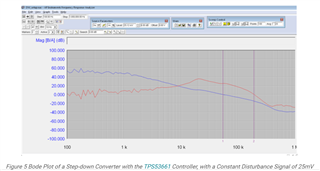Hi,
I am currently conducting a loop stability test for a BUCK converter, mainly testing the Bode diagram. I am confused about the settings and criteria for judging loop stability on the oscilloscope, so I would like to seek your advice.
My output voltage is 5V, input voltage is 9-16V, and the working current is around 5A.
Here are my questions:
1. What is the appropriate range for the starting and cutoff frequencies in the Bode diagram test? My switching frequency is set to approximately 1938KHZ.
2. What is the appropriate amplitude for the alternating signal injected into the loop? I set it to 50mV.
3. What is the appropriate value for the loop injection resistor? I used 50 ohms.
4. What are the reasonable criteria for determining the crossing frequency, gain margin, and phase margin? Can you provide specific criteria? Is this standard applicable to other BUCK ICs as well? I understand that the crossing frequency is generally set to 5-20% of the switching frequency, the absolute value of the gain margin is greater than 12dB, and the phase margin is greater than 45°.
Please help me with this, I really appreciate it!


